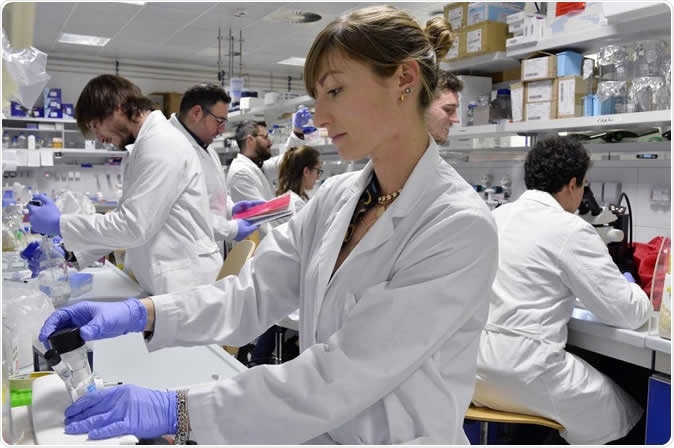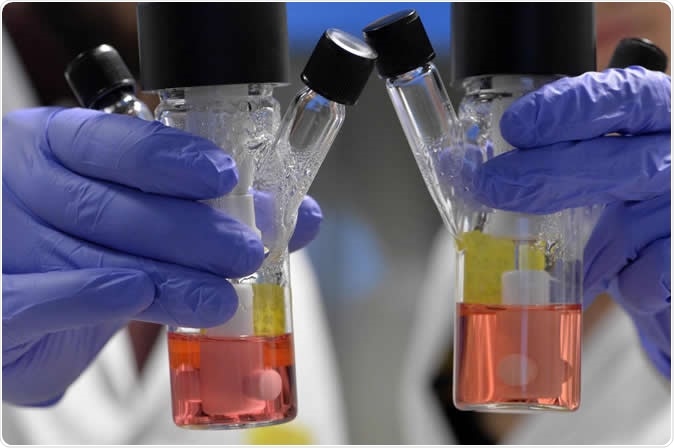A new study reports the creation of in vitro models of brain tumors in children using organoids derived from stem cells, which will help to screen new drugs for efficacy and thus improve the rate of drug development. The study, titled 'Modeling medulloblastoma in vivo and with human cerebellar organoids,' is published in the journal Nature Communications.

The research team coordinated by Luca Tiberi of the Armenise-Harvard Laboratory of Brain Disorders and Cancer of Cibio Department of the University of Trento developed a new strategy to study brain tumors of childhood. Image Credit: ©AlessioCoser for University of Trento
Pediatric brain tumors have been the subject of much research in order to arrive at better modes of treatment. They are the leading cause of death in children with cancer, with medulloblastoma at the top of the list, because of their highly aggressive nature and the difficulty of treating them effectively.
Medulloblastomas are the most common brain tumors in children, and only 70% of children survive 5 or more years from the date of diagnosis, according to the While some drugs are now available, they are associated with sometimes debilitating side effects that linger over the life span of the surviving patient. Moreover, in those patients who develop recurrent tumors, the former treatments don’t work anymore.

Hundreds of Organoids (miniature brains) were grown in the laboratories of the University of Trento to study the genetic mechanisms responsible for the most common brain cancer affecting children. Image AlessioCoser for University of Trento
Organoids
The concept of organoids was a stunning new tool to help investigators in this area test their theories and drugs on a medulloblastoma model. Organoids are miniature organs, or small 3-D cultures of various types of tissue found in a single organ. They are grown in culture from stem cells, which can be molded in various ways to recreate the actual working of an organ, or to study just one aspect of it if desired, by inducing the stem cells to differentiate into only one type of cell. They add immensely to the sum of knowledge at only a fraction of the cost of actual animal experiments.
Neural stem cells are found in the developing brain and a very few areas of the brain after birth, and in adults. They both multiply and differentiate into mature cells, the number of cells which enter each pathway is determined by several connected factors. These same cell pathways go awry in brain disorders and tumors, and it is essential to understand what actually goes wrong to target brain tumors more effectively.
Human induced pluripotent stem cells
To do this, investigators have turned to induced stem cells. When adult skin cells, for instance, are treated in the right way, they turn back their developmental clock to become induced pluripotent stem cells (iPSCs). In humans, these are the human iPSCs, or hiPSCs. These cells are then allowed to differentiate in response to varying stimuli, to enter different pathways of maturation. Among the earliest differentiated cells to be created efficiently from hiPSCs are the neuronal cells. the current study will exploit this technology to create hiPSCs using cells from patients with existing brain disorders. Following their pathway will help understand the defects in the way neural stem cells and differentiated nerve cells work in these patients. This in turn will uncover the disease processes at work in various degenerative and developmental conditions.
Organoids from healthy and sick people
The current study, led by the University of Trento, used the organoid strategy from hiPSCs, based on cells extracted from people with disease. The aim was to find out how the disease influenced the brain cells, both differentiated and to obtain tumor models without live animals. If such models can be produced on a large scale, as is envisaged in the near future, it would be much easier to screen new drug candidates.
The biggest obstacle was the creation of organoids based on brain tumors, which is “very difficult and requires specific scientific capabilities”, according to research coordinator Luca Tiberi. He explains that the organoids were created at the University of Trento using skin or blood cells, and grew as irregular spheres in all directions, to the size of peanuts. They were analyzed and their characteristics described by the researchers at another university. They found signs of disease, which makes it possible to model pediatric tumors.
Tiberi goes on to explain that organoids grown from healthy donors as well helped make comparisons between the two groups, to understand the genes that promote tumor onset and development. The study also confirmed the great importance of the role of proteins Otx2 and c-Myc, as well as allowing several therapies to be tested for efficacy, focusing on the drug Tazemetostat.
Implications
The importance of being able to test these therapeutic options on in vitro tumors is described by Tiberi: “These in vitro tumors will help us fine-tune research on the genes that cause cancer and on possible prevention and treatment strategies. Organoids give us the opportunity to study brain tumors without using experimental animals in a context that is similar to a real-patient scenario. They can be a reliable tool for developing personalized therapies.”
Journal reference:
Ballabio, C., Anderle, M., Gianesello, M. et al. Modeling medulloblastoma in vivo and with human cerebellar organoids. Nat Commun 11, 583 (2020). https://doi.org/10.1038/s41467-019-13989-3